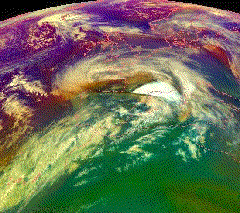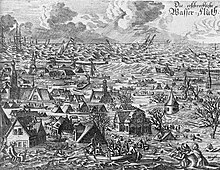
The Burns' Day Storm was an extremely violent windstorm that took place on 25–26 January 1990 over North-Western Europe. It is one of the strongest European windstorms on record and caused many fatalities in the UK and Europe. This storm has received different names, as there was no official list of such events in Europe at the time. Starting on Burns Day, the birthday of the Scottish poet Robert Burns, it caused widespread damage and hurricane-force winds over a wide area.

Cyclone Lothar is regarded as the worst European windstorm recorded during the 20th century. Crossing France, Belgium, Luxembourg and Germany between 25 December and 27 December 1999, Cyclone Lothar resulted in 110 fatalities and more than €15 billion in damage, becoming the costliest European windstorm ever recorded.

Anatol is the name given by the Free University of Berlin to a powerful winter storm that hit Denmark, Southwest Sweden, and Northern Germany on 3 December 1999. The storm had sustained winds of 146 km/h and wind gusts of up to 184 km/h, equivalent to an intense category 1 hurricane, which is unusually strong for storms in northern Europe. The storm caused 20 fatalities; in Denmark alone 7 died and more than 800 were injured.
A superstorm is a large, unusually occurring, destructive storm without another distinct meteorological classification, such as hurricane or blizzard.
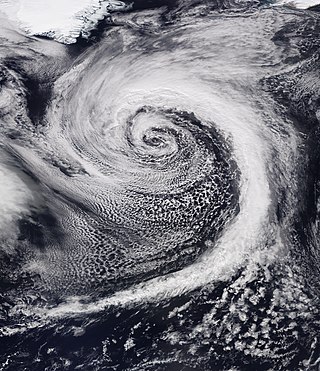
Extratropical cyclones, sometimes called mid-latitude cyclones or wave cyclones, are low-pressure areas which, along with the anticyclones of high-pressure areas, drive the weather over much of the Earth. Extratropical cyclones are capable of producing anything from cloudiness and mild showers to severe gales, thunderstorms, blizzards, and tornadoes. These types of cyclones are defined as large scale (synoptic) low pressure weather systems that occur in the middle latitudes of the Earth. In contrast with tropical cyclones, extratropical cyclones produce rapid changes in temperature and dew point along broad lines, called weather fronts, about the center of the cyclone.

Severe weather is any dangerous meteorological phenomenon with the potential to cause damage, serious social disruption, or loss of human life. Types of severe weather phenomena vary, depending on the latitude, altitude, topography, and atmospheric conditions. High winds, hail, excessive precipitation, and wildfires are forms and effects of severe weather, as are thunderstorms, downbursts, tornadoes, waterspouts, tropical cyclones, and extratropical cyclones. Regional and seasonal severe weather phenomena include blizzards (snowstorms), ice storms, and duststorms.
The following outline is provided as an overview of and topical guide to tropical cyclones:
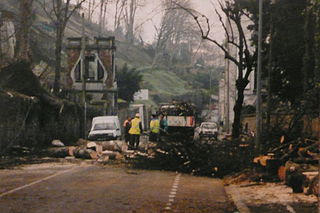
Cyclone Martin was an extremely violent European windstorm which crossed southern Europe on 27–28 December 1999, causing severe damage across France, Spain, Switzerland and Italy one day after Cyclone Lothar had affected more northerly areas. Wind speeds reached around 200 km/h (120 mph) in French department of Charente-Maritime. The storm caused 30 fatalities and €6 billion in damages. Combined with Lothar, Cyclone Martin is often referred to as the Storm of the Century in western and central Europe.

Hurricane Bawbag, also known as Cyclone Friedhelm was an intense extratropical cyclone which brought hurricane-force winds to Scotland at the beginning of December 2011. The storm also brought prolonged gales and rough seas to the rest of the British Isles, as well as parts of Scandinavia. On 8 December, winds reached up to 165 mph (266 km/h) at elevated areas, with sustained wind speeds of up to 80 mph (130 km/h) reported across populous areas. The winds uprooted trees and resulted in the closure of many roads, bridges, schools and businesses. Overall, the storm was the worst to affect Scotland in 10 years, though a stronger storm occurred less than a month afterwards, on 3 January 2012. Although the follow-up storm was more intense, the winter of 2011–12 is usually remembered for Bawbag among Scots.

Cyclone Hergen was an intense European windstorm that moved across Northern Europe during mid December 2011. It was first noted over the central North Atlantic Ocean by the Met Office. It then later reached peak intensity just northwest of Ireland and then crossed the north of Scotland hours later. It hung around the coast of Norway for the next week before being absorbed by another strong windstorm named Joachim.
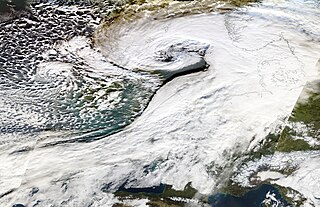
Cyclone Ulli was an intense European windstorm. Forming on December 31, 2011 off the coast of New Jersey, Ulli began a rapid strengthening phase on January 2 as it sped across the Atlantic. Ulli was the costliest disaster in January 2012 globally. The damage from the storm in Glasgow was also compared to a storm in 1968.
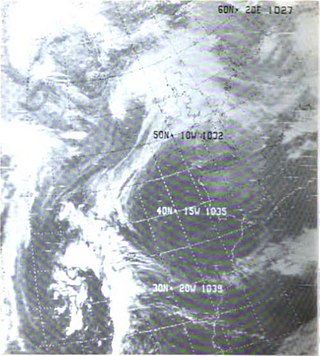
The Gale of January 1976, widely known as the "Capella" storm in Germany and the Ruisbroek flood in Belgium, was one in a series of extratropical cyclones and storm surges, which occurred over January 1976. The gale of 2–5 January 1976 resulted in severe wind damage across western and central Europe and coastal flooding around the southern North Sea coasts. At the time, this was the most severe storm of the century over the British Isles. Total fatalities reached 82 across Europe, although a figure of 100 is given by the World Meteorological Organization. Of these 24 were reported in Britain and 4 in Ireland. Overall losses of US$1.3 billion were incurred, with insured losses standing at US$500 million (1976).

Storm Jeanett was a strong extratropical cyclone and European windstorm which affected much of northwest Europe on 27–28 October 2002. The storm brought strong winds and heavy rainfall, with wind speeds reaching up to 180 km/h uprooting trees, smashing cars and damaging buildings. The storm was responsible for a total of 33 deaths across Europe, including Britain, the Netherlands, France, Austria, Belgium, Denmark, Poland, Switzerland and Sweden. The majority of the fatalities were caused by falling trees.

Weather system naming in Europe follows several multinational schemes under the EUMETNET framework. On the north Atlantic coast, the United Kingdom's Met Office, in collaboration with its Irish counterpart Met Éireann and, since 2019, its Dutch counterpart the Royal Netherlands Meteorological Institute (KNMI), decided to introduce a storm naming system following the St Jude's day storm on 27–28 October 2013 which caused 17 deaths in Europe and the 2013–14 Atlantic winter storms in Europe to give a single, authoritative naming system to prevent confusion with the media and public using different names for the same storms. The first European windstorm to be named was Abigail on 10 November 2015. The definitive list is combined from suggestions from the three countries.

Storm Darwin a European windstorm that Western Europe, particularly Ireland and the United Kingdom on 12 February 2014. The storm brought hurricane-force winds to Ireland the with the Met Office and Met Éireann describing the storm as one of the most significant to affect Ireland, Wales and West England in recent decades. Tini was one of the strongest storms of the 2013–2014 Atlantic winter storms in Europe, and also brought heavy across the UK and Ireland exacerbating the 2013–2014 United Kingdom winter floods, and may have been the most damaging storm of the period.
The 2017–2018 European windstorm season was the third instance of seasonal European windstorm naming. France, Spain and Portugal took part in winter storm naming for the first time this season.

Cyclone Egon was a European windstorm that affected the north of France, Belgium and Germany during the night of Thursday 12 to Friday 13 January 2017. It caused three deaths, widespread power outages, and wind damage and significant snowfall, primarily France and Germany, but also in the Benelux states, Austria and Switzerland.
